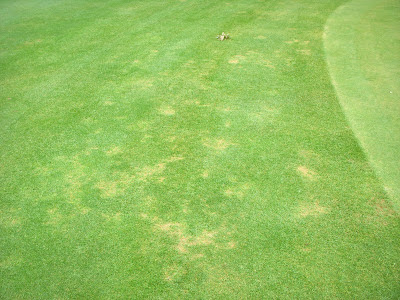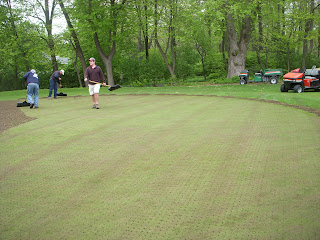Despite the semi-uncooperative weather from Sunday evening through Monday morning, the greens aerification has been completed, and all-in-all, it went very well.
On Sunday afternoon, our fantastic group of overqualified part-time workers allowed us to aerify and clean nine greens. Then, it rained 0.7" and was cool and drizzly on Monday. Because of the muddy, slimy mess that additional aerification would have resulted in on Monday, our efforts were instead focused on backfilling the holes on the front nine. Tuesday brought ideal aerification weather, and we were able to aerify, clean, and backfill the back 9. Between classes, six UW-Madison turf students lent a hand on Tuesday and did a great job as usual.
Below is a photo journal of the process that we use to aerify your greens at Blackhawk:
First, select greens are deep drilled. This machine has 5/8" diameter by 10" long drill bits that are spaced 5" apart. The holes that are created by this machine really help the greens drain well and break the layer between the native soil that the greens were originally built with and the layer of sand topdressing that has been built up over the years.
The deep drill doesn't bring up a lot of soil, but the deep holes stay open for a long time. Because deep drilling is a slow process and because we only own one machine, we're not able to use this method on all of the greens each year. This year, eight greens were deep drilled.
Core aerifying was completed on all of the greens, and if the green was scheduled to be deep drilled, the drilling was done prior to the coring. These machines bring up a 1/2" diameter by 3-4" long core on 2" spacing.
The significant mess is then shoveled to the collars for collection. This is the most back-breaking portion of aerifying, but with enough workers, it's not too bad.
A heavy layer of sand topdressing is then applied to the greens. Given the variable moisture of our sand, it's always tricky to put down the correct amount of sand, but Chad got as close as is possible. This year, approximately 22 tons of sand were used.
Once the sand is good and dry, the greens are drug four times to get the majority of the sand into the holes.
Since the machine drag isn't able to get all of sand into the holes, a large crew that's armed with backpack blowers, shovels, and brooms follows behind and systematically works the sand across the green until the holes are filled and a minimal amount of sand is on the turf canopy. Although time consuming, this allows for the best, smoothest finished product that we can provide.
Lastly, the green is rolled to smooth out any ridges that the aerifiers may have made, the hole is cut, and it's ready to go.
Although it's going to undoubtedly create a wet golf course, the 0.3" of rain that we received this morning helped to further clean the greens by pounding the sand into the turf canopy. With the temperatures that are forecasted for the next few days, we are optimistic for a speedy recovery and for hole-free greens in the near future.
Speaking of weather, Mr. Rath emailed Chad and me the following, "The average temperature for March 2012 was 50.1
°F which was 16.1 degrees above normal. The average in April was 47.9 °F, 2.2 degrees cooler than March! April was also near normal for Madison, finishing 1.3 °F above the average temperature of 46.6 °F." This was the first time in Madison's weather history that March was warmer than April.








































